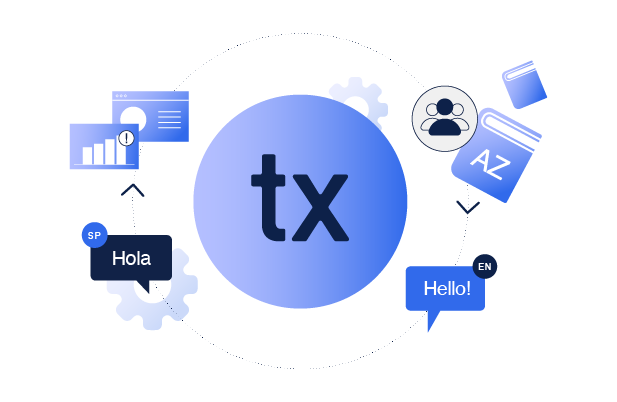A Translation Management System, otherwise also known as a TMS, can be extremely helpful for translating your content to multiple languages. However, many professionals are still relying on spreadsheets, either due to the worries of switching to different technologies or not being aware of these more advanced solutions.
This article is all about helping you understand more about what Translation Management Systems are, how they work, how they can help you, and how you can use them! So, without any further ado, let us get right into it!
What is a Translation Management System?
A Translation Management System is a platform that you can use to translate and localize your product easily, swiftly, and cost-effectively.
The main functionality of a TMS is to:
- Host your content for translation
- Give you everything you need to translate it
- Publish it back to your app/website
And when you dig deeper, you'll find plenty of tools that help you accomplish that, such as:
- Team collaboration tools
- Editing assistance (Glossary, guidelines, tracking, etc)
- Automation features (Machine Translation, Translation Memory, etc)
- Visual context (For video subtitles, general context, etc)
- And more
While all of this can be overwhelming, it’s all going to be much easier to comprehend once we break it all down, one step at a time.
But, in short, a TMS helps you bring all of your team, collaborators, and content into a single place. And in that place, you can easily manage everything and everyone in a much more efficient way compared to the old-fashioned methods of localization while also automating many tasks.
What is Translation Project Management?
As the name implies, translation project management is all about, well, project management. Jira and Asana are two very popular examples of software that companies generally use for project management.
But, what about translation projects? How do you manage something as complex as that? That’s where Translation Management Systems come in!
What is Localization in Translation?
As we’ve already mentioned, a TMS is basically a piece of software that you can use to localize your product more efficiently. But what is localization anyway?
Localization in translation is all about taking a product in its language, usually English, and then making it more appealing/appropriate for a local community.
So, it's not just about translating a sentence from one language to another. It's also about making sure that the translation makes sense and is appealing to the target locale.

Localization apart from translation, in general, may also require you to adapt other forms of media, such as:
- Images
- Videos
- Banners
- Legal documents
- Advertisements
- Animations
- And more, depending on the kind of content you have
This is particularly prevalent in content such as video games, where multiple changes or even censorships are often necessary, depending on the region.
Why Are Translation Management Systems Necessary?
A TMS can make the life of localization managers, translators, and in many cases, even engineers, much easier.
Without a TMS, most people use spreadsheets, instead. And if you find yourself in that category, you already know that crawling through thousands of columns and cells is not exactly ideal.
This kind of workflow, as we are about to soon see, introduces a lot of challenges that are difficult to tackle without specialized software. We are referring to communication challenges, file management problems, quality assurance, etc.
Not to mention anything about:
- Automation
- Team management
- Improving translation quality and speed
- Tool integrations
A TMS can prove to be invaluable in dealing with such issues.
And even without all that, the ROI (Return on Investment) of localization on its own is more than enough to get into localization. So, if you have to localize your product, why not do it more efficiently with modern software?
And there are further benefits still. Localizing your content in numerous languages can help your brand rank in more regions, which means that you are getting more customers while making your brand known across the world.
Last, but not least, it’s important to remember that using a new tool is not just about getting something more; it is also about solving issues and getting rid of problems.
Addressing Localization Challenges With a TMS
Switching from a traditional localization process to a TMS can be a daunting thought, especially if you are not too familiar with software tools and automation, in general.
Before taking a big step, it’s important to think about the reasons why you want to take that step. In this case, what are the precise localization challenges that a TMS helps us with?
File Management
First and foremost, when localizing a product, you must keep track of your files. In most cases, that includes:
- Apps
- Website content
- All of the source content along with its translations in numerous languages
Keeping track of everything, especially while in the midst of localizing, is no doubt a challenging task with old-school localization methods.
However, by using a TMS, you’re basically bringing all of your files and content into a single place, which makes file and content management so much easier.

Think of a CMS (Content Management System) such as WordPress, for example. Without WordPress, you have to spend so much more time looking around for the post that you are after, manage it, tweak around with the code, and don’t even think about using 3rd party plugins unless you really know what you are doing.
But with WordPress, anyone who knows how to use basic apps is able to manage all of the content and plugins with ease. It’s a similar story with Translation Management Systems.
Team Management and Communication
Team communication and team management in localization can be just as difficult as file management, if not more.
Before Translation Management Systems, professionals had no choice but to handle everything through numerous 3rd party communication platforms and links, such as Slack.
Now, we have the choice of bringing administrators, project maintainers, reviewers, language coordinators, translators, engineers, and pretty much anyone, into a single UI where everyone can work and communicate in.

Without a TMS, the only way to fix mistakes is by taking the time to say something like, “There is a typo on French on platform.md at line 34. Please fix it.”. Then the translator is also going to waste valuable time looking for that file, line, and typo.
With a TMS, on the other hand, you simply mark a translation as wrong, the translator gets notified, and then gets to that translation with the press of a button – which saves a ton of time and effort in the long run.

It’s worth keeping in mind that everyone has their own roles and permissions inside the TMS. Thanks to that, you won’t have to worry about translators editing strings that they shouldn’t have access to or anything like that.
Additionally, you can leave comments and notes under content that needs to be translated, you don’t longer have to bother with going back and forth between 3rd party communication platforms, or searching for a translation that needs to be fixed, for that matter. Everything is integrated into the UI (User Interface) of the TMS.
Turnaround Time, Efficiency & Quality Assurance
With the traditional localization process, you need to send the source documents over for translation, then review and make any necessary comments, then back for translation again, until everything is ready.
This is a problem for managing time, human resources, budget, as well as maintaining high-quality standards.
A TMS helps you tackle this issue by improving collaboration between the various teams, giving you the option to leave comments for context under a translation string, as well as visual context if it comes down to it.

For example, the word “Hello” in Greek, can be a:
- Greeting
- Salutation
- Farewell
So, in that case, you need a TMS to give you context for what the word is referring to. This improves translation quality, reduces turnaround time, and gives you an easy way to ensure that translations are accurate.
Furthermore, the Transifex editor has a built-in tool for reviewing completed translations and reassigning them, if it comes down to it – which is an additional step for quality assurance – even before software such as Translation Memory steps in. More about those things later.
Back-End Communication
Localization isn’t just about, well, localizing. A lot of work goes into software engineering before, during, and after localization is completed. And the same thing goes for continuous localization where engineers need to keep on working with the localization team on a regular basis.
A Translation Management System can help you minimize software work and troubleshooting in numerous ways, from using basic solutions such as HTML placeholders to directly editing web content without having to ever interfere with the code.

With a little bit of work, you can even fully automate the whole pull/push process by using something such as Transifex Native! The initial setup no doubt takes a bit more work than a traditional TMS setup, but in the long run, most probably agree that it’s worth it. In fact, Transifex only took a couple of weeks to fully migrate into localizing with Transifex Native and it has proved an invaluable tool for both our collaborators and engineers, too.
Working With Multiple Platforms
Most companies nowadays rely on numerous tools to get their job done – and this is not an exception for the localization industry. It’s not uncommon for a localization team along with the software engineers to be using numerous 3rd party platforms for designing, development, publishing, and more!
And while all these tools are no doubt invaluable, going back and forth between them can be pain-inducing, which is another way where a TMS can come in handy, since most allow you to integrate numerous tools into the software.
Transifex, for example, offers integrations, such as:
- Slack
- Figma
- GitHub
- Python
- WordPress
- Sanity
- Google Translate
- DeepL

And many more!
Automation
Automating as many workflows as you can is crucial for anyone who wants to be more productive with less work – and this is applicable to localization, as well. Obviously, automating something as complex as localization is by no means an easy task, but we can still do it up to a certain degree.
Translation Memory, for example, memorizes translations and automatically fills up identical ones that are yet to be completed by humans. With this kind of automation, you can save tons of time while cutting down on expenses, as well.

Don’t forget about machine translation tools such as Google Translate and DeepL, too. You can use them directly from the TMS’s user interface and while they may not be able to compete with human translators, they can still
You can also use other kinds of automation, such as Transifex’s API, to automatically detect new content, notify the translators about it, then publish the updated content, which is superb for continuous localization.
Furthermore, with the help of integrations and software engineers, the possibilities for automation with a Translation Management System are endless!
How Do You Manage Translations With a Translation Management System?
All this information may feel overwhelming. After all, there are tons of features to choose from and we haven’t even went into detail about them. But there is no need to worry.
Translation Management Systems, including Transifex, come with a friendly user interface and are extremely easy to use. All you have to do is:
- Create a free account
- Upload the content that needs to be translated
- Invite your team and collaborators over
- Start localizing
- Publish your now localized content
And if you need help with anything, you can refer to our how-to videos, documentation, blog, or you can also schedule a demo with one of our representatives!









